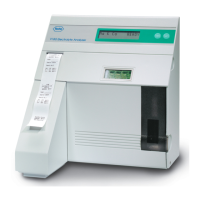Roche Diagnostics
156 Instructions for Use · Version 10.0
10 Troubleshooting 9180 Electrolyte Analyzer
Troubleshooting
Check Sample Sensor The sample sensor is calibrated with air
during each calibration. For proper
operation, the sensor should read between 80
and 120 units. To check the sample sensor
response, perform the sample sensor test.
(Checking reagent fluid level and changing the
SnapPak (p. 145)
Open the sample door and press the YES
button to aspirate various fluids through the
sensor. For transparent fluids (e.g. water), the
reading should increase by at least 40 units.
For blood samples (not transparent), the
reading should decrease by at least 40 units.
The pump can be stopped at any time by
pressing NO.
o Clean the sample sensor by using the Electrode
Maintenance procedure.
o Check for correct drying of the measuring chamber
during the wash cycle.
o Replace the peristaltic pump tube set. (Exchanging the
pump tubing set (p. 140))
o Perform a calibration to remove the error message.
Check Reference
Housing
There is no flow of Reference Solution into
the measuring chamber.
o Check for the proper filling of the reference housing.
o Ensure that the reference tubing is securely connected
to the receptacle.
o Since this test utilizes Standard A, make sure that it is
aspirated properly into the measuring chamber. If not,
replace the SnapPak. (Checking reagent fluid level and
changing the SnapPak (p. 145))
o Clean the reference housing (see Monthly maintenance
(p. 137)).
o Check the peristaltic pump tube set.
o Perform a calibration to remove the error message.
Please close sample
door
The sample door is not closed within
20 seconds after the sample is in place, or the
door has been opened and no sample is
detected.
o Close the sample door within the time allowed.
No sample Under certain conditions, the analyzer may
not detect the presence of a sample:
o Sample door remaining open for more
than 20 seconds after samples are in place
o Air bubbles in the sample
o Sample volume is too small to analyze
o No sample is aspirated through the
sampling mechanism.
If you want to stop a measurement, close the
sample door during sample aspiration.
o Repeat the sample to see if it is detected properly after a
second run.
o Close the sample door within the time allowed.
o Check the sample aspiration and see if there are clots in
the sampling mechanism.
o Ensure that the o-rings are in the correct position and
sealing the electrodes.
o Ensure that the sample sensor is plugged in and test the
sample sensor to verify that it is operating correctly.
(Testing the sample sensor (p. 160))
o Replace the pump tubing. (Exchanging the pump
tubing set (p. 140))
Cleaning fluid not
detected
Under certain conditions, the analyzer may
not detect the presence of cleaning solution:
o Air bubbles in the cleaning solution
o Not enough cleaning solution
o Cleaning solution is not aspirated
properly through the sampling
mechanism
o Ensure that the o-rings are in the correct position and
sealing the electrodes
o Check the aspiration of the cleaning solution and see if
there are clots in the sampling mechanism.
o Ensure that the pump windings are properly sealed.
o Ensure that the sample sensor is plugged in and test the
sample sensor to verify that it is operating correctly.
(Testing the sample sensor (p. 160))
Message Cause Action
Table 10-1

